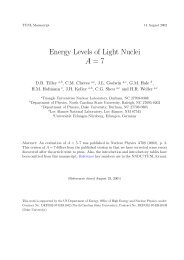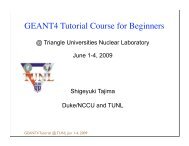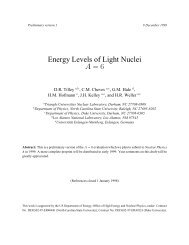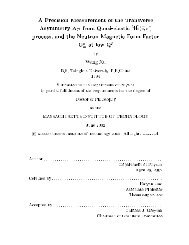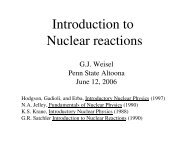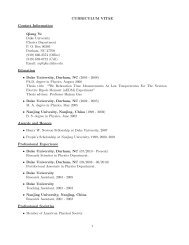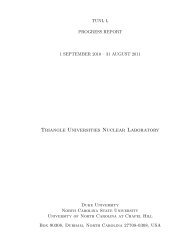Energy Levels of Light Nuclei A = 14 - Triangle Universities Nuclear ...
Energy Levels of Light Nuclei A = 14 - Triangle Universities Nuclear ...
Energy Levels of Light Nuclei A = 14 - Triangle Universities Nuclear ...
Create successful ePaper yourself
Turn your PDF publications into a flip-book with our unique Google optimized e-Paper software.
Angular distributions have been studied at E( 6 Li) = 34 and 62 MeV [see (86AJ01)], at 93 MeV<br />
(86BR33, 87DE1G, 88DE1G, 89DE34; to <strong>14</strong> N*(0, 3.95)) and at 84, 150 and 210 MeV (87WI09,<br />
86AN29, 88AN06; to <strong>14</strong> N*(0, 2.31, 3.95)). <strong>14</strong> N*(3.95) dominates the spectra: see e.g. (87WI09).<br />
<strong>14</strong> N*(5.11, 5.83, 6.20, 7.03, 8.49) are also populated (80WH03, 87WI09). For studies <strong>of</strong> the GT<br />
strength see (80WH03, 87WI09). See also (87AU04, 88AU1E, 88GA1N, 89AU1B) and(86AJ01).<br />
40. (a) <strong>14</strong> N(γ, n) 13 N Q m = −10.5535<br />
(b) <strong>14</strong> N(γ, p) 13 C Q m = −7.55063<br />
(c) <strong>14</strong> N(γ, d) 12 C Q m = −10.27239<br />
(d) <strong>14</strong> N(γ, π + ) <strong>14</strong> C Q m = −139.725<br />
The total absorption over the range E γ = 9 to 31 MeV is dominated by a single peak at 22.5<br />
MeV [estimated σ ≈ 29 mb, Γ ≈ 2 − 3 MeV] and appreciable strength extending beyond 30 MeV.<br />
The cross section cannot be accounted for solely by the (γ, n)and(γ, p 0 ) processes: particleunstable<br />
excited states <strong>of</strong> 13 C, 13 N are involved. The combined (γ, n)and(γ, pn) cross section<br />
begins to rise rapidly above 18 MeV, reaches its maximum value <strong>of</strong> 15 mb at 23.3 MeV and exhibits<br />
structure at about 19, 20.5 and 26 MeV. The main peak (Γ ≈ 3.5 MeV: see (70AJ04)) at 23.3 MeV<br />
appears to be split into two absorption levels: see (81AJ01). Maxima reported in other experiments<br />
and “breaks” in the (γ, n) activation curve are listed in (70AJ04). Most <strong>of</strong> the photon absorption<br />
in the giant resonance region forms J π =2 − states in <strong>14</strong> N which decay by d-wave neutron emission<br />
to 13 N g.s. . Some evidence is found for the existence <strong>of</strong> J π =0 − strength at the peak <strong>of</strong> the giant<br />
resonance and for a small amount <strong>of</strong> isospin T = 0 mixing near 22.5 MeV: see (81AJ01). The cross<br />
section for the (γ, n) reaction has recently been measured from threshold to 15.5 MeV (87FA<strong>14</strong>).<br />
See also (88DI02).<br />
The (γ, p 0 )and(γ, p 2 ) cross sections and angular distributions have been measured in the<br />
giant resonance region. The giant dipole states [(p 3/2 ) −1 (2s1d)] which decay by p 0 emission to<br />
13 C*(3.68) appear to carry ≈ 90% <strong>of</strong> the E1 strength and do not contibute substantially to the (γ,<br />
p 0 ) process which is populated by (p 1/2 ) −1 (2s1d) giant dipole states. Above E γ =22MeVd-wave<br />
emission from 2 − states appears to dominate the (γ, p 0 ) cross section: see (76AJ04). For reaction<br />
(c) see (87IM02). For rection (d) see <strong>14</strong> C.Seealso(85FU1C) and(85GO1A, 86WI10, 87HU01,<br />
87KI1C, 87LU1B, 88DU04; theor.).<br />
41. <strong>14</strong> N(γ, γ) <strong>14</strong> N<br />
A measurement <strong>of</strong> the protons from the <strong>14</strong> N(γ, p) 13 C reaction and a resonant absorption measurement<br />
lead to Γ γ0 /Γ = 0.052 ± 0.004 for <strong>14</strong> N*(9.17) and to Γ = 122 ± 8eV(89VA21). See also<br />
(86AJ01), Table <strong>14</strong>.19, (85BE2F, 87BE1K) and(86DU1F; theor.).<br />
42. (a) <strong>14</strong> N(e, e) <strong>14</strong> N<br />
(b) <strong>14</strong> N(e, ep) 13 C Q m = −7.55063<br />
58



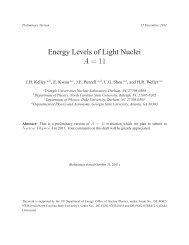

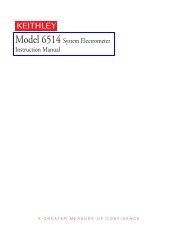
![TUNLXXXIV.tex typeset [1] - Triangle Universities Nuclear Laboratory](https://img.yumpu.com/47618358/1/190x245/tunlxxxivtex-typeset-1-triangle-universities-nuclear-laboratory.jpg?quality=85)
